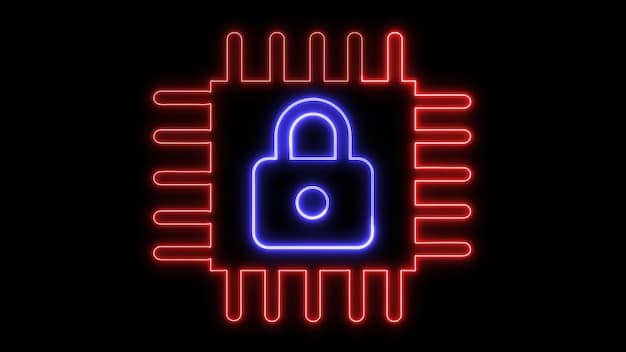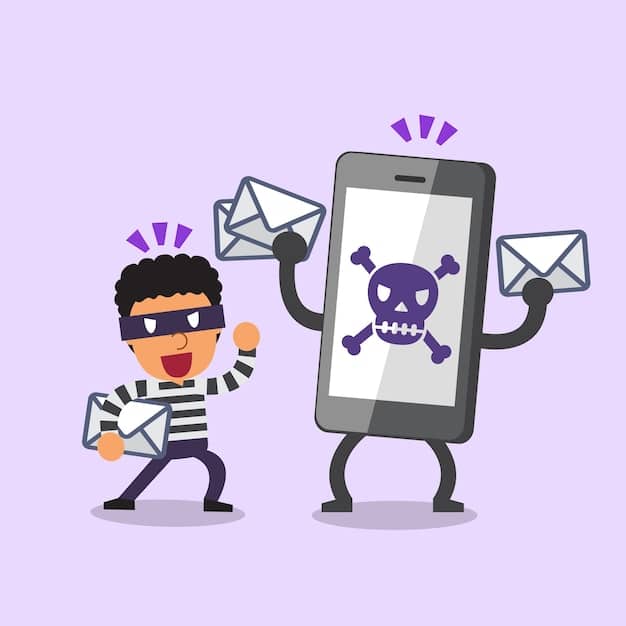Streaming Service Security: Protecting Your Account from Hackers in 2025

Streaming service security in 2025 requires proactive measures like strong, unique passwords, two-factor authentication, and vigilance against phishing attempts to protect accounts from increasingly sophisticated hackers.
In the rapidly evolving digital landscape, ensuring streaming service security: protecting your account from hackers in 2025 has become paramount. With cyber threats becoming more sophisticated, understanding and implementing robust security measures is crucial for safeguarding your personal information and preventing unauthorized access to your accounts.
The Evolving Threat Landscape for Streaming Services
As streaming services continue to dominate the entertainment industry, they also become increasingly attractive targets for cybercriminals. Understanding the evolving threat landscape is the first step in bolstering your defenses. Hackers are constantly refining their techniques, making it essential to stay informed about the latest threats and vulnerabilities.
Common Hacking Methods
Several hacking methods are commonly employed to compromise streaming service accounts. These include:
- Phishing: Deceptive emails or messages designed to trick users into revealing their login credentials.
- Credential Stuffing: Using previously compromised username and password combinations to gain access to accounts.
- Malware and Viruses: Malicious software that can steal login information or compromise devices used for streaming.
Emerging Threats in 2025
Looking ahead to 2025, we can anticipate the emergence of even more sophisticated threats. These may include:
Staying ahead of these threats requires a proactive approach to security, combining robust technical measures with user education and awareness.
In conclusion, recognizing the evolving threat landscape is essential for protecting your streaming service accounts. By understanding common hacking methods and anticipating emerging threats, you can take proactive steps to secure your digital entertainment experience.

Strengthening Your Password Security
One of the most fundamental steps in protecting your streaming accounts is to strengthen your password security. Weak or reused passwords are a common entry point for hackers. Implementing strong password practices can significantly reduce your risk.
Creating Strong, Unique Passwords
A strong password is the first line of defense against unauthorized access. Follow these guidelines to create passwords that are difficult for hackers to crack:
- Length: Aim for a minimum of 12 characters, but ideally 16 or more.
- Complexity: Use a combination of uppercase and lowercase letters, numbers, and symbols.
- Uniqueness: Never reuse passwords across multiple accounts.
Password Managers: A Secure Solution
Given the complexity of managing numerous strong, unique passwords, password managers are an invaluable tool. These applications securely store your login credentials and can automatically generate complex passwords. Popular options include:
- LastPass: A well-known password manager with a free tier and premium features.
- 1Password: A highly secure and feature-rich password manager.
- Dashlane: Another popular option with advanced features like password change alerts.
Password managers not only simplify password management but also enhance your overall security by ensuring that you’re using strong, unique passwords for every account.
Enabling Two-Factor Authentication (2FA)
Two-factor authentication (2FA) adds an extra layer of security to your streaming accounts, making it much more difficult for hackers to gain unauthorized access. Even if a hacker manages to obtain your password, they will still need a second form of verification to log in.
How 2FA Works
2FA works by requiring you to provide two different types of authentication factors when logging in. These factors typically fall into one of the following categories:
- Something you know: Your password.
- Something you have: A code sent to your phone or email.
- Something you are: A biometric identifier like a fingerprint or facial recognition.
Setting Up 2FA on Streaming Services
Most major streaming services now offer 2FA as an option. To enable it, follow these general steps:
- Log in to your streaming service account.
- Navigate to the security or account settings.
- Look for the option to enable two-factor authentication.
- Follow the prompts to set up your preferred method of verification, such as a code sent to your phone or email.
By enabling 2FA, you significantly increase the security of your streaming accounts, adding an essential layer of protection against unauthorized access.
Identifying and Avoiding Phishing Scams
Phishing scams are a common method used by hackers to trick users into revealing their login credentials. These scams often involve deceptive emails or messages that appear to be from legitimate streaming services.
Recognizing Phishing Attempts
Phishing emails often contain several telltale signs that can help you identify them:
- Generic Greetings: Phishing emails often use generic greetings like “Dear Customer” rather than your name.
- Urgent Requests: They may create a sense of urgency, claiming that your account will be suspended if you don’t take immediate action.
- Suspicious Links: Phishing emails often contain links to fake websites that look similar to the real thing.
Best Practices for Avoiding Phishing
To protect yourself from phishing scams, follow these best practices:
- Verify Sender: Always check the sender’s email address to ensure it matches the official domain of the streaming service.
- Navigate Directly: Instead of clicking on links in emails, navigate directly to the streaming service’s website by typing the URL into your browser.
- Report Suspicious Emails: If you receive a suspicious email, report it to the streaming service and delete it immediately.
By being vigilant and following these best practices, you can significantly reduce your risk of falling victim to phishing scams and compromising your streaming accounts.

Securing Your Devices and Network
The security of your streaming accounts also depends on the security of the devices and network you use to access those accounts. Compromised devices or networks can expose your login credentials to hackers.
Keeping Devices Updated
Regularly updating your devices’ operating systems and software is crucial for maintaining security. Updates often include security patches that address known vulnerabilities.
Using a Secure Network
When streaming content, it’s important to use a secure network. Public Wi-Fi networks are often unsecured and can be easily intercepted by hackers. Consider using a virtual private network (VPN) to encrypt your internet traffic and protect your data.
VPNs for Enhanced Security
A VPN creates a secure, encrypted connection between your device and the internet, masking your IP address and protecting your data from eavesdropping. Popular VPN providers include:
- NordVPN: A well-regarded VPN provider with a large network of servers.
- ExpressVPN: Known for its fast speeds and user-friendly interface.
- Surfshark: An affordable VPN option with unlimited device connections.
By securing your devices and network, you can create a safer streaming environment and protect your accounts from unauthorized access.
Monitoring Your Account Activity
Regularly monitoring your streaming account activity can help you detect unauthorized access or suspicious behavior. Most streaming services provide tools to track your viewing history and login activity.
Checking Viewing History
Reviewing your viewing history can help you identify any unfamiliar titles or programs that you didn’t watch. If you notice anything suspicious, it could indicate that someone else has accessed your account.
Reviewing Login Activity
Many streaming services also provide a log of recent login activity, including the date, time, location, and device used to access your account. If you see any unrecognized logins, it’s a sign that your account may be compromised.
Taking Action if Necessary
If you suspect that your account has been compromised, take immediate action to secure it. This may involve:
- Changing your password.
- Enabling two-factor authentication.
- Contacting the streaming service’s customer support.
By actively monitoring your account activity and taking prompt action when necessary, you can minimize the damage caused by unauthorized access and protect your streaming experience.
| Key Point | Brief Description |
|---|---|
| 🔒 Strong Passwords | Use long, unique passwords with a mix of characters. |
| 📱 Two-Factor Authentication | Enable 2FA for an extra layer of security via phone or email. |
| 🎣 Avoid Phishing | Be cautious of suspicious emails asking for login info. |
| 🛡️ Secure Devices | Keep devices updated and use secure networks (VPN). |
Frequently Asked Questions (FAQ)
▼
Streaming service security is crucial to protect your personal and financial information from cyber threats. Compromised accounts can lead to identity theft and unauthorized access to your data.
▼
A strong password should be at least 12 characters long and include a mix of upper and lowercase letters, numbers, and symbols. Avoid using easily guessable words or personal information.
▼
2FA adds an extra layer of security by requiring a second verification method, like a code sent to your phone. This makes it much harder for hackers to access your account, even with your password.
▼
Be wary of emails asking for your login details or financial information. Always check the sender’s address and navigate directly to the streaming service’s website instead of clicking on links.
▼
Immediately change your password and enable two-factor authentication. Contact the streaming service’s customer support to report the incident and review your account activity for any unauthorized charges or viewing history.
Conclusion
In conclusion, ensuring streaming service security: protecting your account from hackers in 2025 requires a multifaceted approach, combining strong password practices, two-factor authentication, and vigilance against phishing scams. By staying informed and proactive, you can safeguard your streaming experience and protect your personal information from cyber threats.





